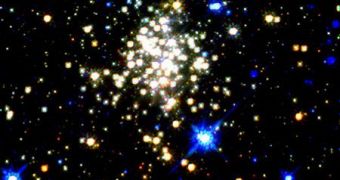Observations made on a star cluster, situated only 100 light years from the core of the Milky Way, suggest that this group of stars is rushing towards the center of the galaxy at phenomenal speeds, deepening the mystery related to the most massive body within our galaxy, the supermassive black hole situated at its center.
The stellar cluster, also known as the Arches, represents a group of very young stars, which is moving towards the galactic core at speeds that cannot be accounted for. Nevertheless, Andrea Stolte from the university of California, Los Angeles, suggests that the Arches cluster will not survive more than a few million years, when it will be destroyed by the powerful gravitational field exerted by the mass situated in the center of the galaxy.
The research was based on previous studies, made by a team including Stolte, meant to observe the trajectory of the cluster. Photographs taken from the 8-meter VLT base in Chile, in 2002, and Keck in 2006, were used to approximate the speed of the star cluster. Keck used a technique that involves using a so-called "laser guide star", that is a laser beam excites the sodium atoms present in Earth's upper atmosphere to create an artificial star, that makes the monitoring of the disturbance in the atmosphere available for real time feedback to prevent the blurring of image coming from out of space.
The available theory on how these star clusters form implies that two clouds of gas collide at relatively high speeds. But there is one problem. In the four years in which the star cluster was monitored, it moved with the seven millionth part of a degree on the night sky, which corresponds to a speed of more than 200 kilometers per second, which is incredibly fast. The cluster, lying more that 25,000 light years away, must have formed after the collision of two fast clouds in the inner galaxy. However, the observation of the clouds which could have formed the Arches proved that they are traveling at much slower speeds than the cluster itself.
To unravel the mystery, Stolte also decided to study another cluster present in that region of space, close to the center of the galaxy to see if Quintuplet, as the cluster is called, also travels at similar speeds.
Although the trajectory and the speed of the Arches cluster gave some information regarding the young stars which lie in the close proximity of the center of the galaxy, it is still a mystery how the stars surrounding the supermassive black hole formed, since the powerful gravitational fields exerted on a cloud of gas would prevent it from collapsing to create stars.
The alternative to the theory regarding stars forming from a cloud of gas around the black hole would be that they did not form there, but they were brought by the powerful gravitational field, which pulled stellar clusters into the core only to destroy them and to put the stars in the orbit of the black hole. However, the Arches cluster will not have the same fate, since its trajectory does not go close enough to the supermassive black hole.
An unusual theory suggests that the stars were actually brought in the central region by a smaller black hole, that might have had a mass of 1000 times that of the Sun, but it is rather unlikely. The most valid assumption is that they actually formed out of an accretion disk of hot dense gas, which collapsed under its own weight to form stars, since stars usually form where they are located.

 14 DAY TRIAL //
14 DAY TRIAL //